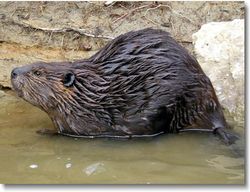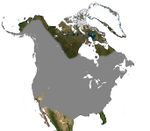North American beaver
| North American beaver |
|---|

|
| Scientific Classification |
|
| Binomial Name |
|
Castor canadensis |
| A North American Beaver swimming |
The North American beaver is a species of beaver known by the scientific name Castor canadensis, which is the largest of the rodents. The North American Beavers are 35 to 46 inches long. They live in rivers, ponds, streams, and small lakes. They are best known for building lodges of sticks and mud. The North American beaver was important in fur trade in the early 17 century. They are originally found anywhere in United states, besides Florida and the desert southwest.
Body Design
The North American Beaver are about 35 to 46 inches long. [2] Their tails are about 10 inches long and they weigh about 44 pounds. When there tail gets slapped on the water that means that they are producing a warning signal. It's tail is used for standing upright and acts as a rudder when swimming. They have feet that are webbed for swimming and long claws, they also have large front teeth. [3] The North American beavers have an inner layer that helps them to keep body heat in cool water. When they are underwater they can see clearly and close off their ears and nostrils. [4]
North American beavers front teeth are harder than on the back, so the back wears faster. This then creates that it's easy for them to cut through wood. [5] Their fur is dark brown and reddish brown. There scaly tails, are also fat storage area. [6] The beaver nose and ears seal underwater. The beaver has a special way from their nose threw their throat which connects their lungs, and this gives them a chance for them to chew and breathe at the same time. They can be underwater for about 15 minutes. Their sense of smell is very important to them because it helps them find food and detect predators. They swim at a speed of 2 mph, but if they are getting chased they can go up to 6 mph. The North American Beavers can only eat 2 pounds to 5 pounds of wood materials a day. [7]
Life Cycle
The North American Beaver will keep one mate and live together for 10-15 years. They stay with their parents until they reach the sexually mature age which is the age of 2 years old. [8] When the beaver is about 3, that's when they start mating. In the North the mating begins from January to March. In the South, its from November to December. When the babies (kits) are born, their eyes are open immediately and swim within 24 hours of birth. They are also born with full fur on them. [9]
The North American beaver female can give birth to 4 kits but can also give 9 kits. The young spend their time in the lodge to be safe from any predators. A colony is a group of single family unit of beavers. The group usually contains 6 to 8 individuals in areas where pressure is low. Beavers live up to 20 years or a little more. [10]
Ecology
North American Beaver can be found across except most of Florida and the southwestern desert areas.[11] They create ponds by building dams from different types of tree materials. They do it to provide protection from different predators. [12] The trees that they feed on are mostly aspen, willow, birch and maple. Aspen and willow are their favorites. They also eat roots of aquatic plants. Their dams have a lot of tree material, branches and mud. The inside of the dam can go up to 6 to 8 feet high. Most of there dams are smaller. They build two different types of lodges. The first one is the one that is constructed in open waters of ponds, and the second one is the bank lodge which is along the banks of larger lakes and rivers. When they build their lodges they can have 2 or more underwater entrances. Inside they rest, feed, and have their young above the water level. [13]
Beavers have negative and positive effects on environment. The negative one is when beavers build there lodges and dams, aquatic plants take over the pond. Then other plants and shrubs will start to grow, and the place will become low grounded. The plants and shrubs will have enough of shade to allow tree seeding to grow. When the trees grow, they will take over the pond and it then will be a woodland place. The positive thing is when they build their dams, they create knew wetland environments. The wetlands help raise the water table, help purify water, and help slow the erosion. [14]
History
In 1500's fur trading began and it was a important role in the United States and Canada for more than 300 years. It was when the Indian and the Europeans exchanged goods. The Indians exchanged fur for tools and weapons. [15] The beavers were expensive, because of their fur. Their skin were filled with layers of fur and other layer of short, tightly-packed hairs. This layer made the people like it and buy it. Beaver fur was good for fashion, warmth, and it's quality. [16]
In the past the North American beaver furs were sold for fur trade. They used their fur for making clothing and beaver hats. In 1620 and 1630 more than 10,000 beavers a year were taken for the fur trade in Massachusetts and Connecticut. About 80,000 beavers were taken from Western New York and the Hudson River from 1630 to 1640. Hudson's Bay Company sent 3 to 2 trading ships every year to take furs from England to Canada in 1670. [17]
Video
North American Beaver Build Dams
References
- ↑ Castor canadensis Wikispecies. Web. last updated October 28, 2013. Unknown Author
- ↑ North American Beaver Montana Outdoors. Web. Accessed January 12, 2015. Unknown Author.
- ↑ North American Beaver Enchanted Learning. Web. Accessed January 5, 2015. Unknown Author.
- ↑ North American Beaver bio expedition. Web. Accessed January 5, 2015. Unknown Author.
- ↑ North American Beaver Washington Department of Fish & Wildlife. Web. Accessed January 5, 2015. Unknown Author.
- ↑ Streubel, Donald. North American Beaver Idaho Museum of Natural History. Web. Accessed January 5, 2015. Unknown Author.
- ↑ North American Beaver Wildlife Response. Web. Accessed January 5, 2015. Unknown Author.
- ↑ American Beaver Castor Canadensis Georgia Museum of Natural History. Web. Accessed 6, 2015. Unknown Author.
- ↑ Life Cycle The North American Beaver. Web. Accessed 6, 2015. Unknown Author.
- ↑ Jackson, Scott and Decker, Thomas.Beavers in Massachusetts UMassAmherst. Web. Accessed 6, 2015. Unknown Author.
- ↑ Living with Wildlife Beaver United States Department of Agriculture. Web. Accessed January 14, 2015. Unknown Author.
- ↑ Beaver Damage Management United States Department of Agriculture. Web. Accessed January 6, 2015. Unknown Author.
- ↑ Streubel, Donald. Castor Canadensis (American Beaver) Idaho Museum of Natural History. Web. Accessed 2000.
- ↑ Beaver - Castor canadensis Nature Works. Web. Accessed January 11, 2015. Unknown Author.
- ↑ Fur Trade Old prison museum. Web. Accessed January 11, 2015.
- ↑ Fur Trade New Nether-land Institute. Web. Accessed January 11, 2015.
- ↑ North American Beaver Wikipedia. Web. Last Modified January 5, 2015. Unknown Author.



